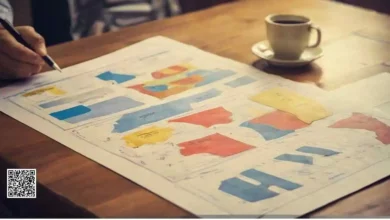Mind Mapping Brainstorming Technique

What is Mind Mapping Brainstorming Technique?
Mind mapping is a visual brainstorming technique that involves creating a diagram of related ideas. The central idea is written in the center of a page, and then branches are drawn out to represent related concepts.
The Mind Mapping technique was developed by Tony Buzan, a British author and educational consultant, in the 1960s. Buzan was a proponent of the idea that traditional linear note-taking methods did not take full advantage of the brain’s ability to make connections between different concepts and ideas.
Buzan’s Mind Mapping technique was designed to be a more creative and intuitive way of taking notes and brainstorming ideas. The technique involves creating a visual diagram of related ideas, with the central idea in the middle and branching out to other related concepts.
Over the years, the Mind Mapping technique has gained widespread popularity and has been used in a variety of fields, including business, education, and personal development. The technique is often used in brainstorming sessions, as well as for organizing and synthesizing complex information.
Today, there are many software tools available that allow you to create Mind Maps digitally, making the technique even more accessible and flexible. Despite the availability of digital tools, many people still prefer to create Mind Maps by hand, as it can be a more tactile and creative process.
How to Use Mind Mapping for Brainstorming
To use mind mapping for brainstorming, follow these steps:
- Define the focus: Start by defining the focus of the brainstorming session. This could be a topic, problem statement, or any other focus point that the group wants to explore.
- Write the central idea: Write the central idea in the center of a page or whiteboard. This central idea should be a clear and concise statement that encapsulates the focus of the brainstorming session.
- Draw branches: Draw branches out from the center to represent related concepts or ideas. These branches should represent the key themes or areas that the group wants to explore.
- Add sub-branches: Add sub-branches to the diagram to represent related ideas and connections. These sub-branches should be connected to the main branches and represent more specific ideas or details.
- Add images, symbols, and colors: Use images, symbols, and colors to help visualize the relationships between ideas. This can help to make the mind map more engaging and memorable.
- Iterate and refine: Continue to add branches, sub-branches, and other elements to the mind map until all relevant ideas have been explored. Once the mind map is complete, review and refine the ideas as necessary.
Advantages of Mind Mapping
Some of the advantages of using mind mapping for brainstorming include:
- Encourages free association and creativity: Mind mapping allows participants to explore ideas in a non-linear and non-judgmental way, which can help to unlock new and innovative insights.
- Organizes complex ideas: Mind mapping can be a useful tool for organizing and structuring complex ideas. By visually representing the connections between ideas, participants can better understand the relationships between concepts and identify new opportunities for exploration.
- Improves collaboration: Mind mapping can be an effective way to facilitate collaboration and teamwork. By allowing participants to contribute their ideas and perspectives to the mind map, the group can build on each other’s insights and create a more comprehensive understanding of the focus topic.
Disadvantages of Mind Mapping
Some of the disadvantages of using mind mapping for brainstorming include:
- Time-consuming: It can be time-consuming to create a detailed and comprehensive mind map, particularly if there are a large number of ideas to explore.
- May not be effective for everyone: The visual nature of mind mapping may not be effective for everyone, and some participants may prefer more traditional brainstorming techniques.
Example – Mind Mapping Brainstorming Technique
Let’s say you are brainstorming ideas for a new product launch.
You could use Mind Mapping Brainstorming Technique to explore different marketing strategies for the launch. Here’s an example of what your mind map could look like:

Mind Mapping Brainstorming Worksheet
Step 1: Define the Central Idea
Write the central idea or topic in the center of the page. This should be a broad idea that the team wants to explore. For example, if you’re brainstorming ideas for a new marketing campaign, the central idea could be “Marketing Campaign Ideas.”
Step 2: Generate Related Ideas
Draw branches out from the central idea and write related concepts on each branch. These can be sub-ideas, keywords, or other related concepts. Encourage everyone to contribute as many ideas as possible, without judging or critiquing them at this stage.
Step 3: Create Sub-branches
For each branch, create sub-branches that explore further related ideas. Use symbols or icons to represent different types of ideas, such as problems, solutions, opportunities, or challenges. Use colors to differentiate between different types of ideas.
Step 4: Identify Connections
Look for connections and relationships between different ideas on the mind map. Use arrows or lines to connect related concepts or show how one idea leads to another. This can help you to identify patterns, opportunities, and areas for further exploration.
Step 5: Evaluate and Refine
Review the mind map and identify the most promising ideas. Discuss the potential strengths and weaknesses of each idea, and refine them to make them more specific, actionable, and feasible.
Step 6: Action Planning
Use the mind map to create an action plan for implementing the most promising ideas. Assign roles and responsibilities, set timelines and deadlines, and identify resources needed to turn the ideas into action.
Conclusion
Mind mapping is a powerful tool for generating, organizing, and refining ideas. By visually representing related concepts, you can identify new opportunities, connections, and relationships that might not be apparent in a traditional brainstorming session.
Use this worksheet to guide your team through a Mind Mapping brainstorming session and see what new ideas you can come up with!




